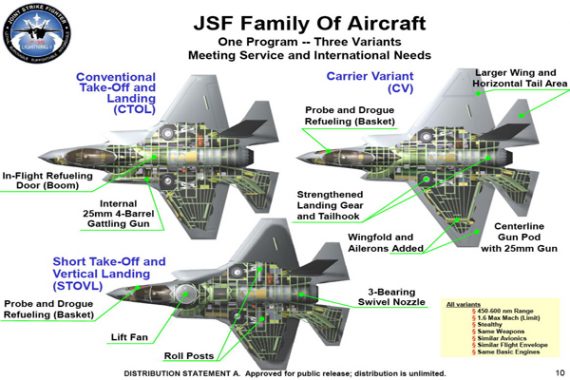F-35 Costs $182 Million to $299 Million Per Plane
Nobody gets the airplane they wanted but at least they're paying more for the one they're getting.
David Axe warns, “The Pentagon’s New Jet Fighter Costs Twice as Much as You’re Being Told.”
In recent weeks several news outlets have repeated the pro-JSF [Joint Strike Fighter] camp’s assertion that the F-35—planned to be the main warplane for the Air Force and Marines and half the Navy’s future fighter fleet—will soon cost just $85 million a copy or less in near-future dollars, thanks to an increasingly efficient production line.
The “good news” helps bolster the $400-billion weapons program, the most expensive ever.
But it’s not true. Not by a long shot. The much-maligned, single-engine F-35—which suffers from a complex design and a lack of maneuverability—currently costs twice what its proponents are projecting. And don’t buy the argument that the jet’s sticker price will substantially drop in coming years. Lockheed’s been making that claim for a long time now, and it hasn’t happened yet.
Trade publications Defense News and Breaking Defense and wire service Reuters all published stories in mid-December quoting Pentagon and Lockheed executives saying the cost of an F-35 is declining. The execs claimed the JSF, which has been in development for 12 years, could wind up being cheaper than competing planes.
Lockheed manager Lorraine Martin made the most outrageous assertion, insisting to Breaking Defense that the F-35 would cost “less than any fourth-generation fighter in the world” by 2019.
[…]
To put the F-35-boosters’ claims in context, Winslow Wheeler, an analyst at the Project on Government Oversight in Washington, D.C., has calculated the true current cost of an F-35. It’s way more than anyone in official circles likes to admit.
Forget the $85-million or $60-million figure being bandied about in the press. Each of the 29 F-35s the Pentagon is purchasing from Lockheed in 2014 costs between $182 million and $299 million. And that’s leaving out research and development spending since the late 1990s, which could soon exceed $50 billion and add $16 million to true long-term acquisition cost of each F-35.
No, Wheeler calculated only the per-plane production cost, which includes advance funding for long-lead parts, the main funding in the year of authorization plus modification funds to fix design flaws on the planes shortly after they roll out of the factory.
By that measure, one Air Force F-35A—the simplest of the three JSF models—currently costs $182 million. A vertical-landing Marine F-35B sets taxpayers back $252 million. The Navy’s carrier-compatible F-35C, still mired in serious development problems, comes in at a whopping $299 million per plane.
A recent RAND study prepared for the Air Force asked, “Do Joint Fighter Programs Save Money?” The short answer: No.
While the idea makes sense—developing, procuring, and sustaining one aircraft rather than two should bring efficiencies—the reality of execution is more complicated.
[T]he need to accommodate different service requirements in a single design or common design family leads to greater program complexity, increased technical risk, and common functionality or increased weight beyond that needed for some variants, potentially leading to higher overall cost, despite the efficiencies.
The report concludes:
The quantitative analysis summarized in this report shows that, contrary to expectations, historical joint aircraft programs have not saved money compared with single-service aircraft programs. Although a joint approach has the theoretical potential to lower acquisition costs by pooling RDT&E resources and increasing production runs, historical joint aircraft programs show substantially higher acquisition cost growth than single-service programs. This higher cost-growth percentage is about twice the maximum theoretical joint acquisition savings percentage for a typical fighter program. In addition, whereas a joint approach can save O&S costs by taking advantage of economies of scale, analysis of actual fighter O&S data shows that the potential savings percentages are small and are not likely to counteract the higher average joint aircraft RDT&E and procurement cost-growth rates. On net, joint aircraft programs have not saved overall LCC compared with single-service aircraft programs.
An important reason for the joint acquisition cost-growth premium is that joint fighter and other complex military aircraft programs have had difficulty reconciling diverse service-specific missions, operating environments, and performance requirements in a common design. The attempt to accommodate different service requirements escalates technical and programmatic complexity and risk, which can drive up costs and prolong RDT&E. At the same time, service-specific requirements and demands tend to produce less commonality and lead to more variants, thus reducing the main source of joint cost savings in procurement and O&S. Even so, necessary design compromises often leave participating services unsatisfied and have often resulted in the withdrawal of partners from historical joint fighter programs. Indeed, of the 11 major historical joint fighter programs we examined dating from the 1960s to the 1990s, all but three led to the withdrawal of one of the partners or cessation of the program very early in the effort, almost always because of conflicts over performance requirements and design.
So, essentially, joint fighter programs like the F-35 are the worst of both worlds: nobody gets the airplane they wanted but everybody pays more.







If you’re going to do something you should go all the way. I for one am proud the U.S. continues to set new heights for the world; we have a native talent for making any good or service cost way too much and I’d hate to see us surrender that position to foreign devils.
$299M here, $299M there.
Pretty soon you’re talking real money.
Meanwhile, I heard (yesterday on NPR) that on a different world called NASA, they are thinking of cutting off funding for the Cassini Solstice Mission so they can save a few million dollars. The satellite is there. It continues to function perfectly. It has successfully completed it’s first 2 missions. The money is basically to keep a few scientists on board receiving and analyzing the data thru the the northern hemisphere solstice so that we have a more complete data set on seasonal variations in the Saturnian atmosphere.
Knowledge. Who needs it?
There was an on-going debate on whether Canada should get the F-35. Looks like another argument for the “No” side.
We tend to make the same mistakes over and over. It is not just Joint programs but the urge to have multi-role aircraft that drive up the costs. In the sixties, it was the FB-111 that became a mess by trying to be both a fighter and bomber. It also started off as a joint AF-Navy program but the Navy bailed. The F-35 is joint but also multirole and multinational. Worst of all worlds.
But it’s important to remember that we can’t afford Social Security, Obamacare, food aid, or unemployment benefits for Americans.
Compared to the f35 program, the Obamacare rollout is a model of efficiency and good government. What’s amazing is just about no one is talking about F35 rollout problems, cost overruns, broken promises, etc. For Conservatives, only one kind of government program needs to be low cost-programs to help the poor and the working class. Programs that enrich defense contractors-no problem. The sky’s the limit.
I’m betting you will NEVER hear about F35 budget overruns and blown deadlines on talk radio or Fox News, but let the Administration blow one deadline or let any feature of the ACA come in over budget, and it’s a wankfest on the conservative blogs, talk radio, and FoxNews.
So, how much will these drive up the cost of a CBG? Those Ford class ships aren’t exactly cheap either.
I’m no defender of the F-35, but David Axe clearly doesn’t know what he’s talking about.
First, we have no idea what an F-35 currently costs, because we haven’t finished designing them yet. The ones that have been built to-date aren’t finished, and are not combat capable. Think of them as prototypes.
Second, prototypes are always much more expensive than the planes you build on an actual production line, using mass-production techniques. The first few F-22s were essentially hand sewn, one at a time. The last few used much more automated assembly.
Third, tactical aircraft really do get cheaper as you make more of them — once you figure out a design and stick to it. A typical learning curve is for the marginal unit cost to go down 15% every time you double the cumulative quantity made. So if the 2nd one cost $100M, the fourth one would cost $85M and the 8th one would cost $72M, etc. This is why the average cost is so sensitive to the size of the total buy.
I agree with Axe that the F-35 is way too expensive, and will never be as cheap as is currently being claimed, and isn’t a very good plane anyway. But anyone who claims to know how much these things will cost eventually is either claiming to be psychic or selling something.
@Stonetools: It’s not a sexy topic but it’s been much-discussed in defense circles for a couple of years now. ObamaCare is, by contrast, a public facing program. And, in fairness, the F-35 is much harder. ObamaCare really just required a decent website to roll out services that already exist. The F-35 required the invention of technology that didn’t exist when the designers dreamed it up.
@DrDaveT: Well, he’s mostly relying on WInslow Wheeler’s calculations, which he links. But, yes, those are just the best educated guesses we have.
Unmanned space programs like Cassini are a bargain. Look at what’s it’s been sending back.
@DrDaveT: Well they’ve made 100 now. How many need to be made before we start seeing the learning curve kick in? It’s my understanding that the $182 million is a real number from the government comptroller. If they can get it down to $100 million by 2018 in then year dollars I’d be ecstatic.
The orangutan’s approach: Keep the C variant for the fleet, the Super Hornet won’t be enough. Ditch the A & B variants: Give the A-10 to the Marines and reprogram PGS for the flydales and UCAVs for the swabbies with the funds saved in cancelling A & B.
NASA also has a perfectly good spacecraft, Messenger, orbiting Mercury. For a trivial amount of money, it’s mission could be extended. Maybe we should just sign it over to China, they seem to have more of “The Right Stuff” than we do these days.
Most of the F-35’s cost (as with every weapon system acquisition program) for the initial lots are the large R&D sunk costs which must be recovered. Let’s just say Lockheed spent $10 billion in its own R&D money to develop the aircraft. That $10B must be spread out amongst the initial purchases, driving up the unit costs (production costs plus R&D recovery costs). Once the R&D costs are fully recovered, the government is left only with the production costs and fee which will be significantly lower.
This this this ^^^. When I first heard of the JSF, I immediately thought of the FB-111, another one of McNamara’s brilliant ideas. It wound up being useful in the end, but oh was it painful.
@rudderpedals:
As much as the Marines would love to get A-10s (and as much as the Air Force would love to finally be rid of them since the A-10 is not pretty enough by their standards) that can’t happen. A-10s can’t be deployed from an aircraft carrier.
Of course, as bad as the F-35 is the Marines did insist on doubling down on the V-22 so it’s not like they’re strangers to poorly designed aircraft.
@Rafer Janders:
Yes, but those are Socialist programs that discourage work and are not directly beneficial to
feudal lords sans titlesNoble Makers.@Al: I know the A-10 won’t ever fit on a carrier. Can we agree it’d be a better fit for CAS than the Osprey or Cobra or a fast mover for the other 90% of the time when the Marines aren’t doing amphibious assaults?
@DC Loser: The $182 million cost is exclusive of R&D. It is only the cost to produce in that year. If you add in all in cost from the beginning of the program the F35C costs runs close to $500 million per
@rudderpedals:
Totally but the Marines and the Air Force would still never go for it though.
As it is the Army asks “Why do we still need the Marines?” quite a bit. If the Marines got the A-10 (or some other aircraft that can’t be deployed on carriers) they’d be asking “Why do we still need the Marines or the Air Force?” which is something neither wants.
Sort of like how we designed the Shuttle to be our pet space Swiss Army Knife and spent zillions on it (a manned vehicle to launch a satellite?) while the USSR kept heaving up satellites on big, brute cheap rockets.
You try to make something a floor wax AND a dessert topping, it’s going to cost more than developing the individual products. And usually your final result doesn’t do a very good job at either of the two things it claims it does.
@rudderpedals:
Closer to 100% — the Marines haven’t really done an amphibious assault since Inchon in 1950, or 64 years ago.
At this point, frankly, I don’t know why we even have a Marine Corps. It’s an extra expense for no extra capacity. Disband them and let the Army and Navy take over their respective functions.
@Al:
Interestingly, from what I can tell anyway, the entire Ford class program will cost about 1/4th of what this boondoggle has set us back.
@Rafer Janders:
You do know that politically, this would never happen, right? The mystique and propaganda of the Marines transcends that kind of logic.
As for the F-35, is there any possibility that we could pull the plug and start over? Or is that impossible for military weapons programs?
@Rafer Janders: @Al:
Robert Farley makes a hopeful but plausible argument for the C model, backed by UCLASS as missile carriers http://thediplomat.com/2014/01/uavs-and-the-f-35-partners-in-air-power/ . Interesting piece
@Stonetools:
Yes, that’s exactly why we still have them — mystique and propaganda. Not because they actually serve any useful purpose as a separate service arm. It’s sentimentality keeps them in business.
@Rafer Janders: As you point out earlier, the Marines haven’t actually done an amphibious landing in combat since Korea. However, there’s always the chance we might need an amphibious assault, and it’s something the Army doesn’t want to do. On that precedent, maybe we could sell the idea of giving the Marines the A-10s and responsibility for Close Air Support, a job the Air Force doesn’t want to do.
(I’d bet it would be a heck of a lot easier to convert the A-10 for carrier operations than it is to graft VTOL equipment onto the F-35. If that fails, it may not strictly need carrier capability. IIRC in WWII the Marines operated the Corsair for some time as a land based A/C before it was carrier qualified.)
@Rafer Janders:
I do note, however, that anytime one of the other services has a downed aviator, or the government needs a rapid response, we (the Corps) get the call.
The usefulness of the Corps in this day and age is speed. We can already be deployed and on the ground in [insert random third world hellhole here] while the Army is still trying to pack its flags and parade bunting away.
@Wayne:
The learning curve doesn’t start until they start making keepers. They have made 100 planes, but they have not made any F-35s yet — the current planes don’t meet the requirements and can’t pass their IOT&E testing. (The wags in my office call it the T-35…)
It’s also misleading to say they’ve made 100, because the A, B, and C variants are fundamentally different planes. Each will have its own learning curve.
@DC Loser:
No, this is not true. It used to be true, back when contractors developed weapon systems on their own dime, then sold them to the government. That doesn’t happen any more, at least not at the high end.
LM developed the F-35 under a series of cost-plus-fee contracts; they are being fully reimbursed (plus profit) for their ongoing development efforts. All of the procurement costs are real, and are driven by the fact that we skipped the tedious technology development portion of the life cycle and jumped into trying to make planes before we even had a working design.
It could be worse — on the JTRS GMR radio program, we set it up so that the developer (Boeing) would continue to make profits until the radio actually worked, at which point they would not be eligible to bid on the production contract. That worked out exactly the way any economist would predict…
@Stonetools:
It’s possible, but rare. The Army cancelled their centerpiece program (Future Combat Systems) when enough people finally realized that (a) it wasn’t going to work, (b) it wasn’t what they needed anyway, and (c) it was going to cost $500 billion dollars.
The Air Force cancelled their premier space program, TSAT, after dumping a ton of money into it, despite the fact that half a dozen other programs were depending on it.
The Navy canned the Zumwalt class destroyer after making only 2 or 3, eating a ton of sunk cost.
The Marines went back to the drawing board twice on the
AAAVEFVACV, their number one priority acquisition program. It’s still on hold, because they can’t resolve the disconnect between what they want and what they can afford.@DrDaveT:
I’d say that it also spotlights the disconnect at MCHQ with regard to the uncomfortable (for older generations of brass) realization that we are, for all practical purposes, no longer an amphibious force. We’re a rapid response force. The resistance to accepting that realization over in the E-ring is quite entrenched.
@DrDaveT: Well that’s the question isn’t it? When will the first F35 that is IOC possible going to come off the line, and how much is it going to cost? When is LM going to advertise real numbers. USAF IOC is supposed to be 2016
It’s not just a learning curve that’s supposed to reduce costs; it’s also the economies of scale. It’s hard to estimate production costs when the total number of units and the number of units per year are both changing. I’m not familiar with a peacetime example of the DoD ordering more units than expected of a big-ticket item, so units always end up costing more than expected.
@HarvardLaw92: Good point. The overall priority of the mission is itself a political hot potato at the moment.
There’s also a huge discontinuity in the feasible design space. You want a slow landing craft that turns into a decent fighting vehicle when it hits the beach? We can do that, and you can afford it. You want a fast landing craft that turns into a troop transport when it hits the beach? We can do that, and you can afford it. You want both fast and good fighting? At that point, we have to make it out of unaffordium — and there’s no such thing as “medium speed”. Either it planes, or it doesn’t.
@Pinky:
This is the other problem with the F-35: as the costs keep going up the orders keep going down. Japan and Canada are threatening pull the plug over the price and I’d be willing to bet Australia and Israel do as well.
The real issues is that Lockheed has enough backers in congress to not get their contract cancelled, whatever they do (or in this case not do). The airplane simply doesn’t meet performance specs. To hide the exploding development costs the AF started to buy junk that will never be combat capable, and is inferior to the airplanes it’s supposed to replace. My only hope is that Boeing will find a way to blow up that cabal and force Lockheed to deliver what the promised (unlikely) or the DoD to reopen the contracts using legal challenges to the procurement process.
@gVOR08:
There really isn’t. At least, not any remotely probably chance.
Why not? Remember that in WWII, the amphibious assaults on French Morocco, Sicily, Salerno, Anzio, the South of France, Normandy, and the Philippines were all conducted exclusively by the Army, not the Marines.
There’s simply no need to incur the cost in both dollar and administrative terms to maintain a separate service arm supposedly specializing in a part of warfare that’s really no longer relevant and that hasn’t been practiced in over 60 years. There’s nothing the Marines do that isn’t already being done by the Army and Navy.
@HarvardLaw92:
Eh, that’s very overstated. While the Marines are indeed used as rapid deployment forces (I’m just going to abbreviate as RDF) he Army also already has RDF capacity, such as the 82nd Airborne, the XVIII Airborne Corps (of which the 82nd is a part), the Rangers, etc. which are just as fast and capable, and the Army also maintains additional RDF support equipment in the form of LMSR ships, etc.
Again, if we need extra RDF, just beef up the Army’s units – no need to maintain a duplicative separate service arm.
@Rafer Janders:
Yeah, but think of the nice uniforms.
Think of the slogans
“We’re looking for a few good men”
“Come on, you bastards, do you want to live forever?”
“All right, they’re on our left, they’re on our right, they’re in front of
us, they’re behind us…they can’t get away this time”
“If the Army and Navy ever ,
Gaze up on heaven’s scenes,
They’ll find the streets are guarded,
By United States Marines”
Think of Tripoli, Saipan, Khe Sanh.
Lots of history there, which is why the USA will always have a USMC.
@stonetools:
You want history, go to a museum.
But yeah, at this point the USMC is basically a special-interest lobby.
@James Joyner:
OK, I linked through and read Wheeler’s article. That’s a bit more nuanced — he explicitly makes the point that you’re not going to get learning until the design is stable. I wish he hadn’t folded together the three variants into an “average F-35”, though, given that an important part of his point is that there’s no such thing — it’s three distinct aircraft. Part of the growth in unit cost over the past couple of years is that the B and C variants are a higher proportion of the annual buy, but he doesn’t mention that.
Still unaffordable, any way you slice it.
@Rafer Janders: ….the “FEW,THE PROUD, AD NAUSEUM!”…..THE US Marines are an anachronism from,as stated, the late 1940’s-50’s era!
We don’t need Marines any longer, except an army which trains, if need be, in amphibious landings…which have not been done since 1950 Korea!